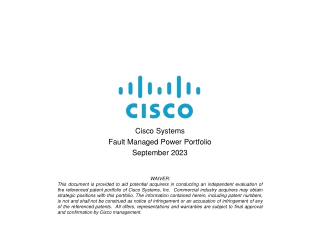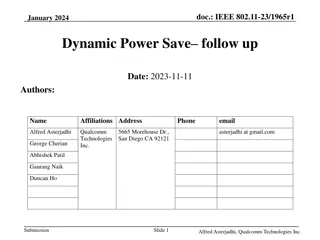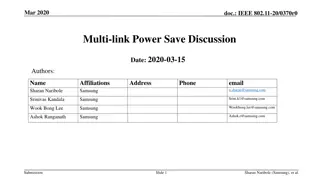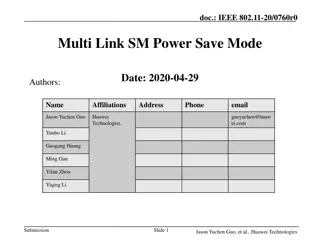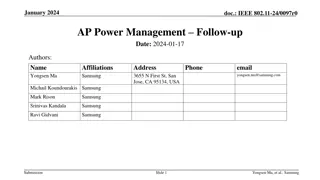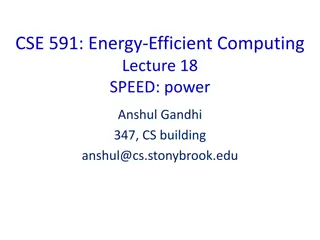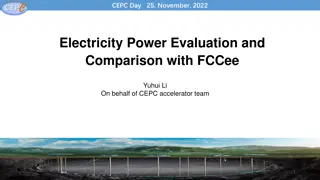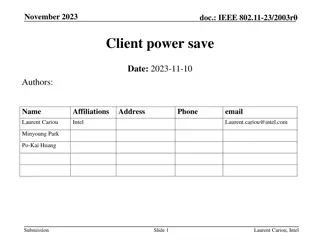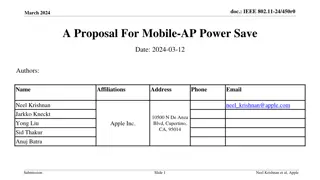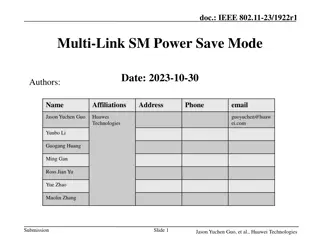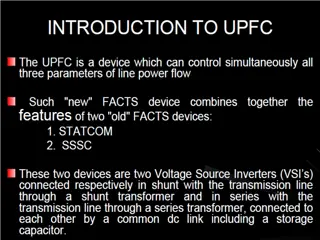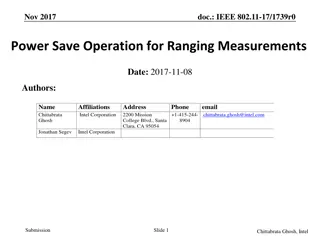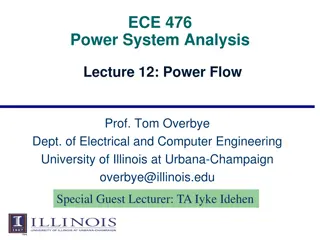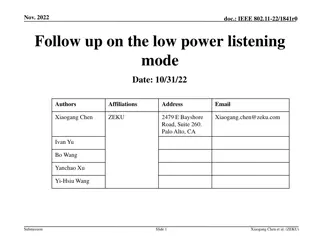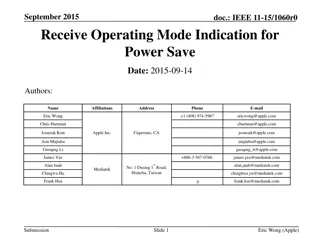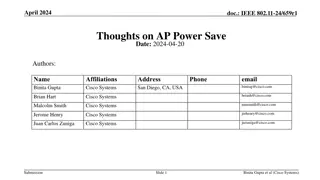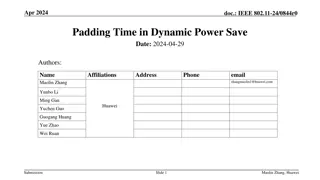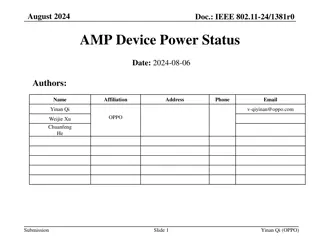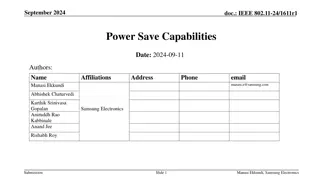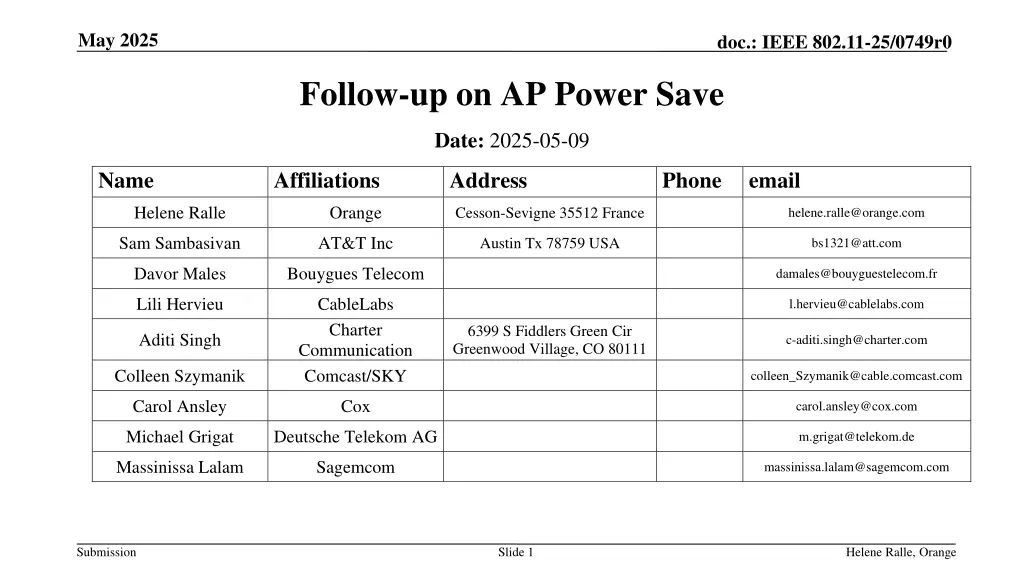
Power Consumption Mitigation for Wi-Fi Access Points in Telecommunication Sector
Operators in the telecommunication sector are under pressure to reduce power consumption in residential broadband gateways, particularly due to Wi-Fi usage. This document discusses the need for efficient solutions for APs to address power consumption challenges and meet carbon neutrality targets set by regulatory bodies like the EU. Various advantages of reducing AP power consumption are highlighted, emphasizing the importance of sustainable practices in the industry.
Uploaded on | 2 Views
Download Presentation

Please find below an Image/Link to download the presentation.
The content on the website is provided AS IS for your information and personal use only. It may not be sold, licensed, or shared on other websites without obtaining consent from the author. If you encounter any issues during the download, it is possible that the publisher has removed the file from their server.
You are allowed to download the files provided on this website for personal or commercial use, subject to the condition that they are used lawfully. All files are the property of their respective owners.
The content on the website is provided AS IS for your information and personal use only. It may not be sold, licensed, or shared on other websites without obtaining consent from the author.
E N D
Presentation Transcript
May 2025 doc.: IEEE 802.11-25/0749r0 Follow-up on AP Power Save Date: 2025-05-09 Name Affiliations Address Phone email Helene Ralle Orange Cesson-Sevigne 35512 France helene.ralle@orange.com Sam Sambasivan AT&T Inc Austin Tx 78759 USA bs1321@att.com Davor Males Bouygues Telecom damales@bouyguestelecom.fr Lili Hervieu CableLabs Charter Communication Comcast/SKY l.hervieu@cablelabs.com 6399 S Fiddlers Green Cir Greenwood Village, CO 80111 Aditi Singh c-aditi.singh@charter.com Colleen Szymanik colleen_Szymanik@cable.comcast.com Carol Ansley Cox carol.ansley@cox.com Michael Grigat Deutsche Telekom AG m.grigat@telekom.de Massinissa Lalam Sagemcom massinissa.lalam@sagemcom.com Submission Slide 1 Helene Ralle, Orange
May 2025 doc.: IEEE 802.11-25/0749r0 Abstract Operators are pressured to reduce the power consumption of their residential broadband gateways. A big part of this power consumption is due to Wi-Fi. Power consumption is even more significant since the introduction of 6 GHz which added a third radio At present only one solution for non-mobile AP power save has been voted into 11bn. We need more solutions, including backward compatible solutions. Submission Slide 2 Helene Ralle, Orange
May 2025 doc.: IEEE 802.11-25/0749r0 Background: power consumption mitigation for APs With the European Climate Law, the EU is committing to carbon neutrality by 2050. Telecommunication operators must reduce their emissions footprints. They focus on the major sources of scope 3 emissions, such as handset, residential gateways, network equipments it represented 81% of Orange carbon emissions in 2023. More globally, 221 companies of the telecommunication sector have targets to reduce their carbon emissions: Target dashboard - Science Based Targets Initiative Most of power saving features in Wi-Fi are addressing non-AP STAs, because they are often battery-powered devices, while APs are wall-powered and need to be always awake. We need efficient solutions for APs. Submission Slide 3 Helene Ralle, Orange
May 2025 doc.: IEEE 802.11-25/0749r0 Illustration of a tri-band AP power consumption Measurements performed by Orange on its 802.11ax tri band gateway By default, even without any traffic, the Wi-Fi represents 50% of the total energy consumption of this residential gateway Aggregation of total household power consumption is increasing (more frequency bands, more devices) Submission Slide 4 Helene Ralle, Orange
May 2025 doc.: IEEE 802.11-25/0749r0 Other advantage of reducing the AP power consumption Reducing the AP power consumption increases its service life Increases customer satisfaction due to cost savings for customers Submission Slide 5 Helene Ralle, Orange
May 2025 doc.: IEEE 802.11-25/0749r0 Constraints The features must be backward compatible It must be possible to enable them even if pre 802.11bn devices are associated to the AP More constraints on the 2.4GHz band where IoT devices are still using old Wi-Fi versions The features must not prevent the AP from receiving packets from associated STAs Submission Slide 6 Helene Ralle, Orange
May 2025 doc.: IEEE 802.11-25/0749r0 Related work Many contributions already presented discuss some existing features for power save and proposed new solutions Existing features are not always implemented / widely supported Existing solutions include (but are not limited to): BW reduction Nss / antennas reduction Limitation of the 802.11 capabilities (generation/MCS etc) Disablement of a frequency band: in particular the 6GHz band if there is no 6GHz capable device in the home, even in addition the 5GHz when there is no traffic Submission Slide 7 Helene Ralle, Orange
May 2025 doc.: IEEE 802.11-25/0749r0 Adopted (non-Mobile) AP power save mechanism in 802.11bn Define a new mechanism and/or enhance existing mechanism for AP power save [Motion #49 and [2, 9, 11, 12]] Scheduled periodic power save on AP side is performed in UHR using Broadcast TWT with TWT ID=0 with Responder PM=1 (Rules for TWT scheduling AP) [Motion #161] Compatible with legacy devices? Operators need additional solutions Submission Slide 8 Helene Ralle, Orange
May 2025 doc.: IEEE 802.11-25/0749r0 Summary 802.11bn needs more power saving features for non-mobile APs Backward compatible features for existing generations of STAs New features for 802.11bn and future generations of APs and STAs Submission Slide 9 Helene Ralle, Orange
May 2025 doc.: IEEE 802.11-25/0749r0 References [1] 11-22/1809 A Perspective on UHR Features for Operator Residential Deployments [2] 11-23/10 Considerations for enabling AP power save [3] 11-23/15 AP MLD power management [4] 11-23/225 Considering Unscheduled AP Power Save [5] 11-23/2112-01 Power Save for UHR [6] 11-23/1922-01 multi-link sm power save mode [7] 11-23/1936-00 ap mld power-save follow-up [8] 11-23/1965-02 dynamic power-save follow-up [9] 11-24/2040-01 Enabling AP power save Follow Up [10] 11-24/589-00 Dynamic TID-To-Link Mapping for AP MLD Power Save [11] 11-24/659-01 Thoughts on AP Power Save [12] 11-24/671-00 Enhancements on AP Power Save [13] 11-24/813-00 Discussions on AP Power Save Submission Slide 10 Helene Ralle, Orange
May 2025 doc.: IEEE 802.11-25/0749r0 References [14] 11-24/1166-00 TWT-Based Power Save with Enhanced Flexibility [15] 11-24/1167-00 EML(SR/MR) Based Dynamic Power Save Design [16] 11-24/1502-00 Discussion on AP Power Save [17] 11-24/1602-01 Power Save Enhancements in UHR [18] 11-24/2001-00 Multi-Link scheduled Power Save for AP MLD [19] 11-25/355-00 Considerations for AP Dynamic Power Save [20] 11-24/578-00 TWT-Based AP Power Save [21] 11-25/355-00 Considerations for AP Dynamic Power Save Submission Slide 11 Helene Ralle, Orange

